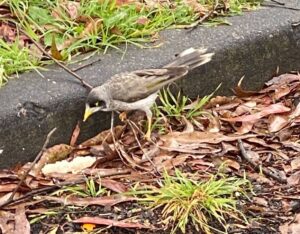To find out more about birds and bird watching ‘Burke’s Backyard’ visited bird expert and author, Graham Pizzey at his home at Dunkeld, 250km west of Melbourne in Victoria.
Graham is fascinated by birds and has watched them all his life. He has just released a new book on bird identification called Field Guide to the Birds of Australia, which he has written with Frank Knight. The book provides information on 778 species of birds with 2500 colour illustrations. It is suitable for both beginner and skilled bird watchers.
Graham Pizzey’s 40 hectare (100 acre) property edges the Grampians National Park and is a haven for birds. Graham has noted about 150 different species in his garden. These include pelicans, which have been seen flying overhead, and wild emus, which came to the property during the recent drought searching for feed.
How to identify birds
Following are some of Graham’s tips for identifying birds.
Start by becoming familiar with a few local species. Learn to recognise by sight and sound the dozen or so birds around your area. Use these as a guide to other birds you may see in other areas.
Use a good field guide (a bird identification book) to help to clearly and precisely identify the birds you see. A book such as Graham’s allows you to work from a general idea of the type of bird you are viewing to a specific identification as the birds are grouped into sections such as a parrot, a hawk, or duck (waterfowl). Once you’ve decided the broad group into which the bird falls go to that section to pick it out from the pictures and written description.
Look for outstanding features on the birds:
Note the bill size, shape and colour, whether it is hard for cracking open seeds or whether it’s long and thin for extracting nectar, like a honey-eater. The bill can explain much about the kind of bird you are looking at.
Examine the bird’s feet. Look at whether it has two toes forward and two back for climbing like a parrot or whether it has sharp talons like a bird of prey.
Check colour and markings of face, head, throat, breast, tail, upper parts, rump and wings. Does the bird have a white eyebrow, eye-ring, wingbars or breast bars? Look at the feather patterns on the bird.
Is its tail short, long, square, rounded, pointed or fish-shaped? Does the tail wag gracefully sideways, quiver quickly up and down or slowly rise up and down.
Observe the behaviour of the bird:
Does it perch upright, crouch along the branch or cling to a trunk sideways? How does it get about?
In flight does it undulate, fly straight and level with regular wingbeats, or is its flight broken by glides? Does it hover motionless or soar in high circles?
Does it fly with wings drooped, flat or markedly upswept?
Listen to whether the wings make a whistling sound in flight, a quick flip-flop sound or rustle like heavy silk.
If it is a waterbird, does it skitter across the surface, leap cleanly into flight or dive into the water.
How to use binoculars
When bird watching, a good pair of binoculars is extremely useful. They will be more effective when used properly. Graham has some tips for the correct use of binoculars:
Choose a pair of binoculars that suits you with a good wide angle view.
Buy the most expensive pair you can afford as price is generally an indication of quality and binoculars are a lifetime investment. Well cared for, a good pair will last more than 20 years.
When using binoculars people search for the birds with the binoculars. But because binoculars have a narrow angle of view and the human eye sees about 180 deg. it is better to search for the bird with the naked eye. Then lock them onto the bird, and move the binoculars smoothly into your line of vision without moving your head. With some practice this can work equally for birds in flight and stationary ones.
Purchasing binoculars can be confusing because there is a large range on the market.
The standard power of binoculars is 10, which brings the object 10 times closer, magnifying the object 10 times.
Spotterscopes, also called telescopes or monoculars, are 20 power magnification, bringing the bird 20 times closer. Although bringing greater magnification these narrow the field of vision. They also require a tripod.
Prices range between $300 to $2800 for a good pair of binoculars. The Nikkon monocular costs about $800 to $900.
Further reading
For more information about bird watching and identification buy Graham Pizzey and Frank Knight’s Field Guide to the Birds of Australia (Harper Collins, 1997, rrp $35) or John Dengate’s Attracting Birds to your Garden in Australia (New Holland Publishers, 1997, rrp $39.95).



